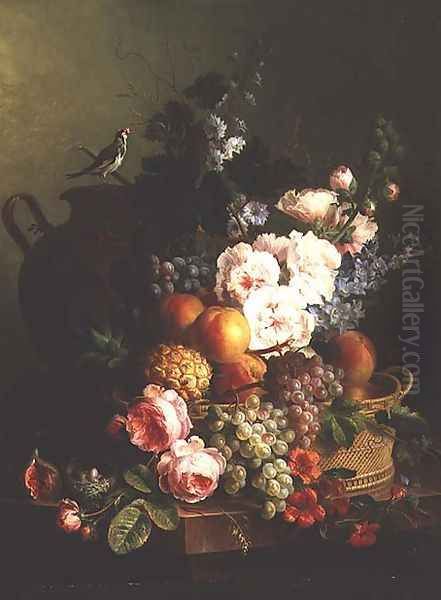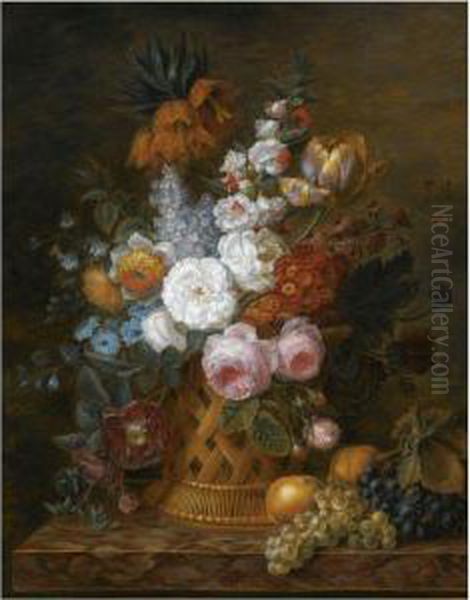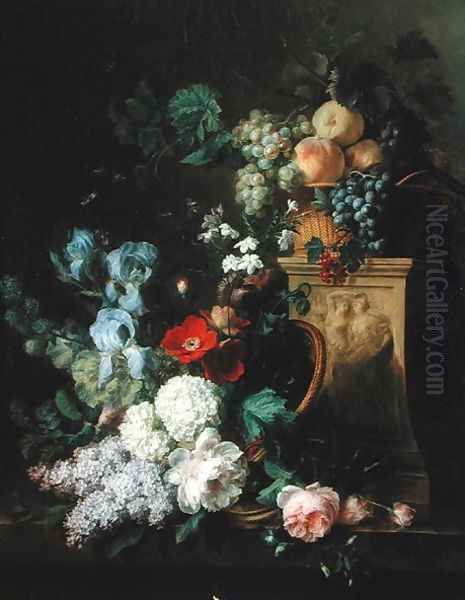
Cornelis van Spaendonck, a name synonymous with the delicate beauty and enduring allure of floral still life painting, stands as a significant figure in late 18th and early 19th-century European art. Born in Tilburg, in the Dutch province of North Brabant, on December 7, 1756, he emerged from a nation with a rich, centuries-old tradition of still life painting. His career, however, would largely unfold in Paris, the vibrant artistic capital of Europe, where he absorbed new influences, achieved considerable fame, and contributed significantly to the art of his time, particularly in the realm of flower painting and decorative arts. His death on December 22, 1839, marked the end of a long and productive life dedicated to capturing the ephemeral beauty of nature with remarkable precision and artistry.
Early Life and Artistic Foundations
The Netherlands, during the 17th century, often referred to as the Dutch Golden Age, had witnessed an unprecedented flourishing of still life painting. Artists such as Jan Davidsz. de Heem, Willem Kalf, Rachel Ruysch, and Jan van Huysum had elevated the genre to extraordinary heights, creating opulent and meticulously detailed depictions of flowers, fruit, and other objects. This rich artistic heritage undoubtedly formed the backdrop to Cornelis van Spaendonck's early artistic inclinations. While detailed records of his earliest training in Tilburg are scarce, it is known that his elder brother, Gerard van Spaendonck (1746-1822), was a pivotal figure in his artistic development.

Gerard was already an established and highly respected painter, particularly renowned for his exquisite flower paintings and miniatures. It was under Gerard's guidance that Cornelis likely received his foundational training. The brothers shared a close artistic bond, and their styles would often exhibit striking similarities, a testament to their shared learning and mutual influence. This familial artistic environment provided Cornelis with a strong grounding in the techniques and aesthetics of Dutch floral painting, characterized by its emphasis on realism, intricate detail, and vibrant, carefully observed color. Before long, the allure of greater artistic opportunities would draw both brothers away from their homeland. Cornelis is also documented to have studied in Antwerp under Willem Jacob Herreyns, a Flemish painter and director of the Antwerp Academy, further broadening his artistic education before his decisive move to France.
The Parisian Sojourn: A Flourishing Career
In 1773, Cornelis van Spaendonck made the significant move to Paris, joining his brother Gerard who had already established himself there. Paris at this time was a crucible of artistic innovation and patronage. The Royal Academy of Painting and Sculpture (Académie Royale de Peinture et de Sculpture) dominated the official art world, and the biennial Salons were the premier venues for artists to exhibit their work and gain recognition. Cornelis quickly integrated into this dynamic environment, continuing his artistic education and forging connections with fellow artists.
His talent for still life, particularly his floral compositions, did not go unnoticed. He began exhibiting at the Paris Salon, where his works were met with critical acclaim. The Parisian public and connoisseurs appreciated his meticulous technique, the freshness of his colors, and the lifelike quality of his floral arrangements. His paintings were seen as continuing the esteemed tradition of Dutch flower painting while also possessing a distinct elegance that appealed to French sensibilities. Artists like Jean-Baptiste Monnoyer had earlier popularized grand floral still lifes in France, and Anne Vallayer-Coster was a contemporary who also excelled in still life, creating a receptive environment for Spaendonck's specialized talent. His success in Paris was a testament to his skill in adapting and refining his Dutch-honed techniques within a new cultural and artistic context.
The Art of Cornelis van Spaendonck: Style and Technique
Cornelis van Spaendonck's artistic style is characterized by several key elements that define his contribution to still life painting. His primary subject matter was flowers, often presented in baskets, vases, or as loose bouquets, sometimes accompanied by fruit or subtle allusions to the natural setting, like a bird's nest or insects.

Meticulous Realism and Detail: At the heart of his style was an unwavering commitment to realism. Each petal, leaf, and stem was rendered with extraordinary precision. He paid close attention to the specific botanical characteristics of each flower, capturing their unique textures, forms, and even their subtle imperfections. This almost scientific accuracy, a hallmark of the Dutch tradition exemplified by artists like Ambrosius Bosschaert the Elder and later Jan van Huysum, gave his paintings a sense of immediacy and truth to nature. Dewdrops on petals, the delicate fuzz on a stem, or the intricate veining of a leaf were all depicted with painstaking care.
Rich and Harmonious Color Palette: Van Spaendonck was a master colorist. His palettes were typically rich and vibrant, employing a wide range of hues to capture the diverse beauty of the floral world. Pinks, reds, yellows, blues, and whites were combined in harmonious arrangements, creating compositions that were both visually striking and aesthetically pleasing. He skillfully used light and shadow (chiaroscuro) to model the forms of the flowers, giving them a three-dimensional quality and enhancing the luminosity of their colors. The interplay of light across different textures, from the velvety softness of a rose petal to the waxy sheen of a tulip, was a particular strength.
Compositional Elegance: While his works were deeply rooted in realism, they were also carefully composed for maximum artistic effect. His arrangements, though appearing natural, were thoughtfully constructed to create a sense of balance, rhythm, and harmony. Flowers were often arranged in a seemingly casual yet artful manner, with blooms spilling gracefully from containers or intertwined in complex bouquets. He frequently used a dark, neutral background, a common device in still life painting, which served to accentuate the brilliance of the flowers and make them stand out dramatically. This technique was masterfully employed by earlier Dutch artists like Willem van Aelst.
Influence of Dutch Tradition and Parisian Refinement: Cornelis van Spaendonck's art represents a beautiful synthesis of his Dutch heritage and the prevailing tastes of his adopted city. The meticulous detail and botanical accuracy clearly stem from the Dutch Golden Age tradition. However, his compositions often possess a certain lightness and elegance that resonated with French Rococo and early Neoclassical aesthetics. Unlike some of the more overtly moralizing vanitas still lifes of the earlier Dutch period, his works primarily celebrate the sheer beauty and decorative potential of flowers, though the inherent symbolism of blooms (representing transience, beauty, and life) was likely understood by his audience.
Masterpieces and Signature Works

While a comprehensive catalogue raisonné is complex for artists of this period, several works are consistently attributed to Cornelis van Spaendonck and exemplify his style. Titles such as "Basket of Flowers" (often appearing in variations like "A Basket of Flowers" or "Still Life with a Basket of Flowers") and "Vase of Roses" are frequently associated with his oeuvre.
In a typical "Basket of Flowers," one would expect to see a profusion of blooms – roses, tulips, peonies, carnations, irises, and other varieties – artfully arranged in a wicker basket. The textures of the different flowers and the basket itself would be rendered with his characteristic precision. The composition would likely be dynamic, with some flowers reaching upwards, others cascading downwards, creating a sense of natural abundance. The interplay of colors would be a key feature, with warm and cool tones balanced to create a harmonious whole. Small details, such as a ladybug on a leaf or a dewdrop on a petal, would add to the painting's realism and charm.
His depictions of roses, a perennially popular subject for flower painters, would showcase his ability to capture the velvety texture of their petals and their complex, layered forms. Whether presented in an ornate vase or as part of a larger bouquet, his roses would be rendered with both botanical accuracy and artistic sensitivity. The influence of artists like Pierre-Joseph Redouté, a contemporary botanical illustrator of immense fame, particularly for his rose depictions, can be seen in the broader European fascination with precise floral representation during this era.
His works often featured a variety of flowers that bloomed in different seasons, a common convention in Dutch flower painting that allowed artists to showcase their skill and create an idealized vision of nature's bounty, unconstrained by the limitations of a single season. This practice also subtly underscored the artist's mastery and the constructed nature of the artwork.
The Sèvres Connection: Porcelain and Decorative Arts
Beyond his easel paintings, Cornelis van Spaendonck made significant contributions to the decorative arts through his association with the prestigious Sèvres porcelain manufactory. For a period, he served as the director of the painting studio at Sèvres, a role that underscored his reputation and his skill in detailed floral depiction, which was highly sought after for porcelain decoration. His brother Gerard also had connections with Sèvres, further highlighting the family's prominence in this sphere.

At Sèvres, Cornelis would have been responsible for creating designs and potentially overseeing the execution of floral motifs on exquisite porcelain pieces. These items, ranging from vases and tableware to decorative plaques, were destined for aristocratic and royal patrons, including the French court. His miniature floral paintings on porcelain demanded an extraordinary level of precision and a refined sense of design, adapting his painterly skills to a different medium and scale. This work at Sèvres demonstrates the versatility of his talent and his ability to apply his artistic vision to different forms of art. The meticulousness required for miniature painting on porcelain was a natural extension of the detailed approach he took to his oil paintings.
Teaching and Influence: A Lasting Legacy
Cornelis van Spaendonck was not only a prolific painter but also a respected teacher. He, along with his brother Gerard, imparted their knowledge and techniques to a new generation of artists. Among his notable pupils was the Danish painter Johan Laurentz Jensen (1800-1856), who became one of Denmark's foremost flower painters. Jensen's work clearly shows the influence of the Spaendonck brothers in its meticulous detail and vibrant coloring, carrying their tradition into the mid-19th century.
Other artists who are said to have studied with or been influenced by Cornelis include Cladius Detlef Fritzsch and Christoffer Wilhelm Eckersberg, the latter being a pivotal figure in the Golden Age of Danish Painting, though his primary focus was not still life. The fact that artists from other countries sought instruction from him speaks to his international reputation. Through his students and the widespread appreciation of his paintings, Cornelis van Spaendonck's influence extended beyond his own lifetime, contributing to the continued vitality of floral still life painting. His dedication to teaching ensured that the specialized skills and aesthetic principles he championed were passed on, enriching the artistic landscape of Europe.
The Van Spaendonck Brothers: A Shared Artistic Journey
The artistic relationship between Cornelis and Gerard van Spaendonck is a significant aspect of their respective careers. Gerard, being the elder and initially more established brother, undoubtedly played a mentoring role for Cornelis. They worked in close proximity in Paris, and their artistic styles often converged, leading to occasional difficulties in attribution for art historians. Both brothers excelled in floral painting, sharing a commitment to botanical accuracy and refined execution.
Their collaboration, whether direct or indirect, contributed to the high esteem in which Dutch-style floral painting was held in Paris. They represented a continuation of this strong tradition on French soil, adapting it to contemporary tastes while retaining its core qualities. Gerard achieved great renown, becoming a professor of floral painting at the Jardin des Plantes in Paris and painter to King Louis XVI. While Cornelis may not have reached the same official heights as his brother in terms of prestigious appointments, his own artistic achievements were substantial, and he carved out a successful and respected career. Their shared journey underscores the strength of familial artistic dynasties and the power of mutual support and influence in the art world.
Context: The Dutch Tradition and French Elegance
Cornelis van Spaendonck's career spanned a period of significant artistic and social change in Europe. He began his work when the Rococo style, with its emphasis on lightness, elegance, and asymmetry, was still influential, and he continued painting through the rise of Neoclassicism, with its more austere and ordered aesthetic, and into the early Romantic period. While his subject matter remained consistent, his work can be seen as bridging these stylistic shifts.
His art embodies the enduring appeal of the Dutch floral tradition, which emphasized close observation of nature, technical virtuosity, and often, subtle symbolic meanings related to the transience of life and beauty (vanitas). However, working in Paris, his paintings also absorbed a degree of French elegance and decorative sensibility. They were less about overt moralizing and more about the celebration of beauty and the display of artistic skill. His works were perfectly suited to the refined interiors of the Parisian elite, serving as objects of delight and testaments to the owner's sophisticated taste. He was part of a lineage of Netherlandish artists, including figures like Jan Frans van Dael, who found success in Paris by specializing in floral still lifes.
In 1833, late in his career, Cornelis van Spaendonck became a member of the Barbizon School (or at least associated with artists who would form its core). While his detailed, polished style differs significantly from the looser, more atmospheric approach of Barbizon landscape painters like Théodore Rousseau or Jean-Baptiste-Camille Corot, his membership might reflect a shared appreciation for the direct observation of nature, a principle that, in its own way, underpinned his meticulous floral studies.
Later Years and Enduring Recognition
Cornelis van Spaendonck continued to paint and remain active in the Parisian art world for many decades. He lived to the advanced age of 83, passing away in Paris in 1839. By the end of his life, he had produced a substantial body of work that had consistently found favor with collectors and critics.
Today, his paintings are held in the collections of major museums around the world, including the Louvre Museum in Paris, the Musée d'Orsay in Paris, the Metropolitan Museum of Art in New York, and the Rijksmuseum in Amsterdam, among others. The presence of his works in these esteemed institutions attests to his lasting importance in the history of still life painting. His art continues to be admired for its technical brilliance, its exquisite beauty, and its faithful yet poetic depictions of the floral world. Auction records and exhibitions dedicated to still life painting frequently feature his work, demonstrating a continued market appreciation and scholarly interest.
Cornelis van Spaendonck's legacy lies in his mastery of a specialized genre, which he pursued with unwavering dedication and skill. He successfully navigated the competitive art world of Paris, building a distinguished career that honored his Dutch artistic roots while embracing the sophisticated tastes of his adopted city. His floral still lifes remain a vibrant testament to the enduring human fascination with the beauty of nature, captured through the discerning eye and skilled hand of a master painter. His contribution, alongside that of his brother Gerard and other contemporaries like the great botanical artist Pierre-Joseph Redouté, ensured that the art of flower painting reached new heights of refinement and popularity at the turn of the 19th century.